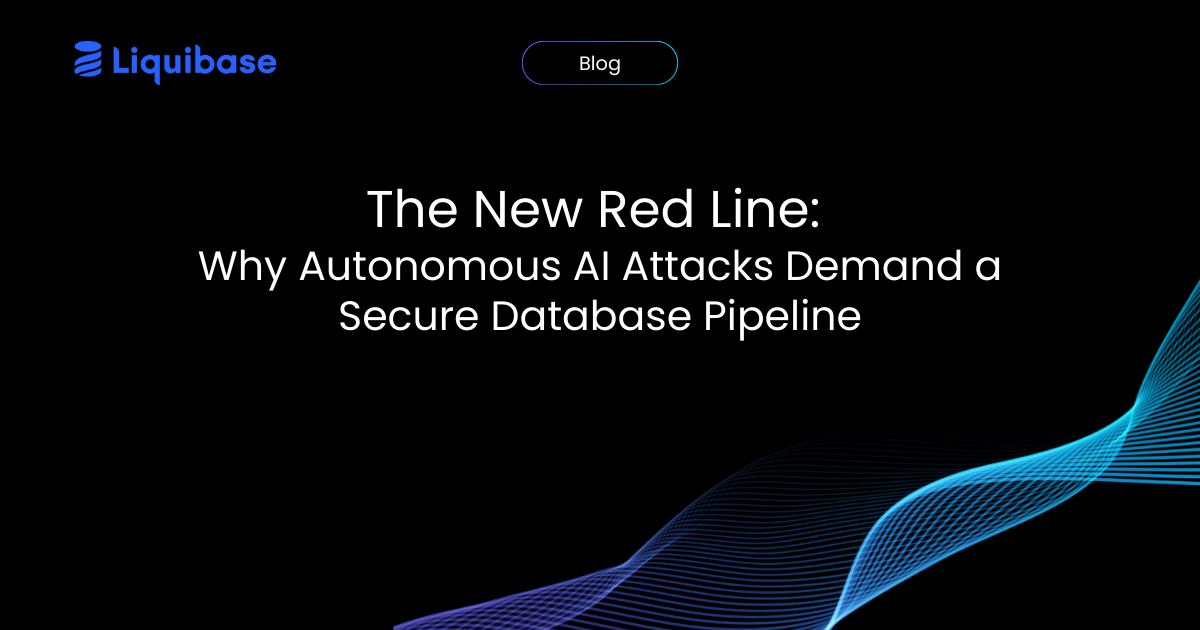Why AI Governance Can't Wait
The Strategic Imperative for 2025
November 6, 2025
See Liquibase in Action
Accelerate database changes, reduce failures, and enforce governance across your pipelines.

Every board meeting now includes AI on the agenda. Every earnings call gets questions about AI strategy. And every CISO is getting asked the same question: "How are we governing this?"
The pressure to deploy AI is real. The competitive threat of not deploying it is even more real. But here's what's keeping enterprise leaders up at night: the gap between AI ambition and AI readiness.
Most organizations are rushing to implement AI without first securing the foundation it depends on: their databases.
The Uncomfortable Truth About AI Governance
AI governance frameworks look great in slide decks. Policy documents get circulated. Committees get formed. But when you dig into what's actually being governed, there's a massive blind spot: the database layer where AI training data lives, where schemas evolve, and where a single ungoverned change can corrupt everything downstream.
You can have all the model governance in the world. You can review every algorithm for bias. You can document every decision. But if your database changes aren't governed, you're building on sand.
And unlike model governance, which is new territory for everyone, database governance is something we actually know how to do. The tools exist. The practices are proven. There's no excuse for getting this wrong.
Why 2026 Is Different
Three things are converging right now that make database governance for AI non-negotiable:
AI agents are moving from experimental to operational. They're not just analyzing data anymore. They're writing code, generating SQL, and proposing schema changes. Some are even deploying those changes autonomously. That velocity is incredible until something breaks. And when it breaks at 2am because an agent dropped a production table, your incident response plan better be airtight.
Regulations are catching up. The EU AI Act goes into effect with real teeth. NIST's AI Risk Management Framework is becoming the de facto standard for federal contractors. State-level AI bills are proliferating. All of them have one thing in common: they require demonstrable control over AI systems and the data feeding them. "We're working on it" won't cut it anymore.
The C-suite is waking up to data layer risk. For years, database change management was seen as a DBA problem. Not anymore. When a database issue takes down a customer-facing AI application, it's not an IT incident. It's a business continuity crisis that lands on the CEO's desk and tanks your stock price.
What "Good Enough" Actually Looks Like
AI governance doesn't require perfection. It requires control, visibility, and the ability to prove both.
That means every database change, whether written by a human, an agent, or a model, goes through the same validation process. Policy checks run throughout your pipeline: before deployment to catch issues early and after deployment to verify that what actually happened matches what was expected. Risky operations get flagged. Non-compliant changes get blocked. And everything leaves an audit trail that can withstand regulatory scrutiny.
Consider a scenario that plays out regularly in development environments: a developer adds a new column to a customer_accounts table during routine deployment. If that column contained unmasked social security numbers or other sensitive PII, it creates significant risk of accidental exposure before proper masking procedures or security reviews kick in. This represents a common but dangerous gap where well-intentioned developers inadvertently introduce compliance violations. Liquibase Secure's policy checks scan all new or modified columns for sensitive data patterns, including SSNs, credit card numbers, and email addresses. When a pattern match is detected, deployment is immediately halted or flagged for mandatory security review. The developer receives clear guidance on required masking or encryption controls. Automated detection prevents accidental PII exposure while maintaining development velocity.
It means drift detection that catches unauthorized changes before they cascade into production issues. It means rollback capabilities that work when you need them, not just in staging. It means your data lineage is documented, your schema evolution is tracked, and you can answer "what changed and why" without starting a forensics investigation.
None of this is theoretical. Organizations already managing database changes this way are moving faster with AI, not slower. They're deploying models with confidence because they know the data layer is stable. They're passing audits because their evidence is already collected. They're recovering from failures quickly because their rollback procedures actually work.
The Cost of Waiting
Some organizations are taking a "wait and see" approach to AI governance. They're watching to see what competitors do. They're waiting for clearer regulatory guidance. They're delaying investment until the business case is ironclad.
That approach has a cost:
- Technical debt accumulation: Shadow changes are piling up. Inconsistencies are spreading across environments. The schema drift that seems manageable today becomes the migration nightmare that blocks your AI roadmap next year.
- Competitive disadvantage: While you're waiting, competitors with proper governance are accelerating. They're experimenting safely, deploying confidently, and building trust with customers who care about responsible AI.
- Regulatory exposure: Retrofitting governance after deployment is exponentially more expensive than building it in from the start. Ask any organization that's tried to document data lineage after the fact.
Where to Start
If you're looking at AI governance and feeling overwhelmed, start with the database layer. It's the highest-leverage move you can make right now.
Start by getting visibility into how database changes happen today. Who's making them? How are they reviewed? What policies exist? Where are the gaps? Most organizations discover they have less control than they thought.
Then standardize the process. One approval workflow. One set of policy checks. One way to document changes. It doesn't have to be perfect on day one. It just has to be consistent and auditable.
Finally, connect database governance to your broader AI strategy:
- Schema changes affect model performance
- Data lineage supports explainability and compliance requirements
- Audit trails enable regulatory validation
- Version control for databases creates the same accountability you expect from application code
These aren't separate initiatives. They're all part of the same picture.
Building AI-Ready Databases with Liquibase Secure
Here's where most AI governance strategies fall short: they focus on governing the models while leaving the database layer unprotected. Liquibase Secure closes that gap by bringing enterprise-grade governance directly into your database change process.
Liquibase Secure integrates into your existing CI/CD pipelines and DevSecOps workflows, enforcing policy checks before any change reaches production. Whether that change comes from a developer, a DBA, or an AI agent, it goes through the same validation process. Risky operations get blocked. Non-compliant changes get flagged. And every modification leaves a complete, tamper-evident audit trail.
What makes Liquibase Secure essential for AI governance:
- Pre-deployment policy enforcement: Catch AI-generated or human errors before they impact production, preventing downtime and data integrity issues
- Complete audit trails: Every change is logged with author, timestamp, rationale, and approval chain - exactly what regulators want to see
- Drift detection and remediation: Automated monitoring catches unauthorized changes across all environments, with alerts and rollback capabilities that actually work
- Universal platform support: Consistent governance across 60+ database platforms, from PostgreSQL to MySQL to MongoDB - no gaps in coverage
- Schema-level data lineage: Track exactly where AI training data originated, how database structures evolved, and why changes occurred
- Observability integration: Stream change logs into your existing monitoring tools for real-time visibility
Organizations using Liquibase Secure for AI governance aren't slowing down to stay compliant. They're accelerating safely. Their developers can experiment with AI capabilities while automated guardrails prevent catastrophic mistakes. Their security teams can prove control without becoming bottlenecks. Their audit teams can produce evidence in minutes instead of weeks.
Most importantly, they're building AI on a foundation that won't crumble under regulatory pressure or operational stress.
The Strategic Reality
AI governance can't wait. It's a right-now imperative for any organization deploying AI in production, using AI agents, or subject to regulatory scrutiny. Which is basically everyone.
Database governance won't make headlines the way a new AI model does. But it's what separates organizations that scale AI successfully from those that stall out, get fined, or suffer a public failure.
The good news? You don't need to solve every AI governance problem at once. But you do need to secure the foundation. Because everything else you're building depends on it.
And unlike most AI challenges, this one has a known solution. The only question is whether you'll implement it proactively or reactively.
Ready to build AI governance that actually works? See how Liquibase Secure brings enterprise-grade control to your database layer without slowing down innovation. Schedule a demo to learn how organizations are governing AI safely while moving faster than ever.



.png)

.png)
.png)
.png)





